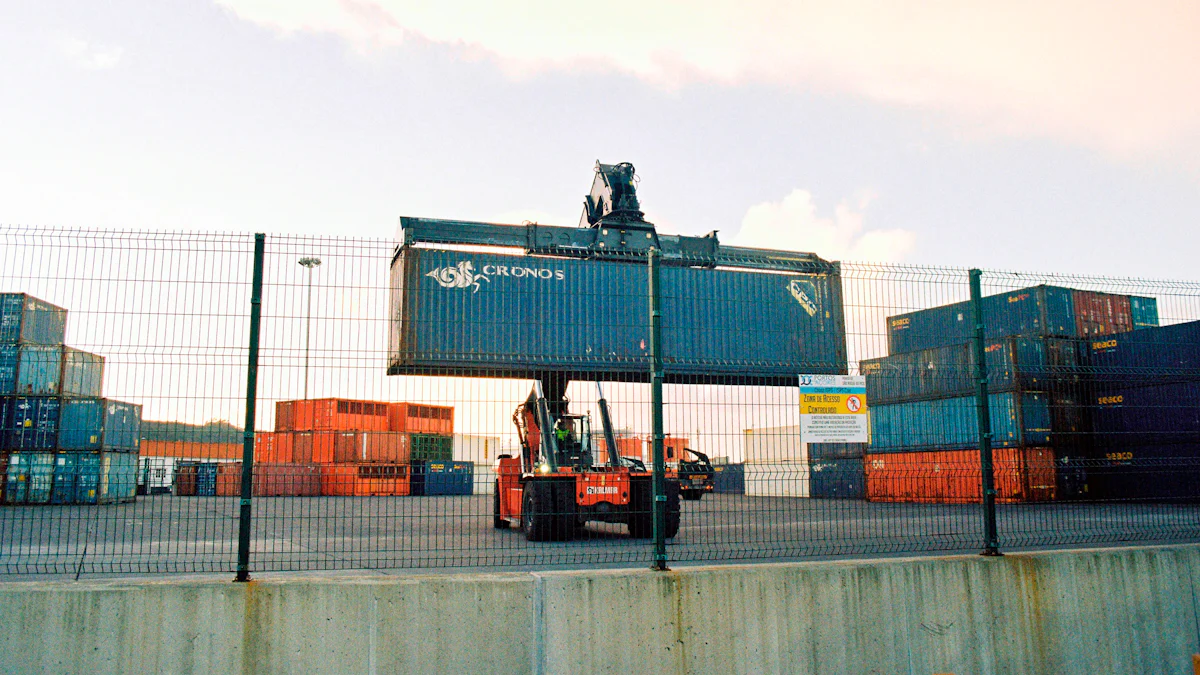How to Create an Eco-Friendly Supply Chain

An eco-friendly supply chain focuses on integrating sustainable practices into every stage of the supply chain process. Prioritizing sustainability in supply chains is crucial for reducing environmental impact, cutting operational costs, and enhancing brand reputation. Throughout this blog, readers will explore the core principles of sustainability, learn actionable steps to create an eco-friendly supply chain, and understand the significance of monitoring and improving sustainable practices.
Understanding the Basics of an Eco-Friendly Supply Chain
Key Principles of Sustainability
To establish an eco-friendly supply chain, companies must adhere to key sustainability principles. Reduce, Reuse, Recycle forms the foundation for minimizing waste and maximizing resource efficiency. Prioritizing Energy Efficiency throughout operations reduces carbon footprints and operational costs. Effective Waste Management strategies ensure responsible disposal practices, contributing to environmental preservation.
Benefits of an Eco-Friendly Supply Chain
Embracing an eco-friendly approach yields various benefits. The positive Environmental Impact includes reduced pollution levels and conservation of natural resources. Companies also experience significant Cost Savings through efficient resource utilization and streamlined processes. Moreover, a sustainable supply chain enhances Brand Reputation, attracting environmentally conscious consumers and fostering long-term loyalty.
Steps to Create an Eco-Friendly Supply Chain

Mapping Your Supply Chain
Identifying All Components is the initial step in building a sustainable supply chain. This process involves mapping out every element of the supply chain, from raw material suppliers to end consumers. By understanding the complete network, companies can identify areas for improvement and implement eco-friendly practices effectively.
Analyzing Environmental Impact is a critical aspect of mapping the supply chain. Companies need to assess how each component contributes to environmental sustainability. This analysis helps in pinpointing areas with high carbon footprints or excessive waste generation, enabling targeted interventions for enhanced sustainability.
Assessing Your Current Supply Chain
Conducting a Sustainability Audit allows companies to evaluate their existing supply chain practices against sustainability criteria. This audit involves assessing energy consumption, waste generation, and overall environmental impact. By conducting a thorough audit, organizations can identify strengths and weaknesses in their current processes.
Identifying Key Areas for Improvement is the next step after conducting the sustainability audit. Companies need to pinpoint specific areas where sustainable practices can be integrated or enhanced. This could involve optimizing transportation routes, reducing packaging waste, or sourcing materials from environmentally responsible suppliers.
Implementing Sustainable Practices
Sourcing Eco-Friendly Materials is a fundamental strategy in creating an eco-friendly supply chain. Companies should prioritize materials that are renewable, recyclable, or biodegradable. By choosing sustainable materials, organizations can reduce their environmental footprint and support responsible sourcing practices.
Optimizing Transportation and Logistics plays a crucial role in enhancing supply chain sustainability. Companies can reduce emissions by consolidating shipments, utilizing greener transport modes like rail or sea freight, and implementing efficient route planning strategies. These initiatives not only cut down on carbon emissions but also improve operational efficiency.
Reducing Energy Consumption across all operations is essential for building an eco-friendly supply chain. Companies can achieve this by investing in energy-efficient technologies, optimizing warehouse lighting systems, and adopting renewable energy sources where feasible. Lowering energy consumption not only reduces costs but also minimizes environmental impact.
Engaging Stakeholders
Collaborating with Suppliers
Collaborating with suppliers is a vital aspect of building an eco-friendly supply chain. Establishing clear sustainability standards and expectations ensures that suppliers align their practices with environmentally conscious principles. By fostering open communication and collaboration, companies can work together with suppliers to source materials responsibly, reduce waste generation, and enhance overall supply chain sustainability.
Educating Employees
Educating employees about the importance of sustainability in the supply chain is key to driving meaningful change within an organization. Training programs and workshops can raise awareness about eco-friendly practices, encouraging employees to adopt sustainable behaviors in their daily tasks. By empowering employees with knowledge and skills related to sustainability, companies create a culture of environmental responsibility that permeates throughout the entire supply chain.
Communicating with Customers
Effective communication with customers is essential for promoting transparency and trust in an eco-friendly supply chain. Companies should openly share information about their sustainable initiatives, such as sourcing practices, energy-efficient operations, and waste reduction strategies. By engaging customers through marketing campaigns, product labeling, and online platforms, organizations can educate consumers about the environmental benefits of choosing eco-conscious products and services.
Monitoring and Improving Your Eco-Friendly Supply Chain

Setting Sustainability Goals
Setting Sustainability Goals is a pivotal step in advancing towards an eco-friendly supply chain. Establishing Short-term Goals allows companies to implement immediate changes that contribute to sustainability objectives. These short-term goals serve as milestones for progress evaluation and provide a clear roadmap for ongoing improvements.
In parallel, defining Long-term Goals sets the trajectory for sustained environmental impact reduction and operational efficiency enhancement. Long-term goals encompass broader strategic initiatives aimed at transforming the entire supply chain into a more sustainable and eco-conscious ecosystem.
Tracking Progress and Metrics
Tracking Progress and Metrics involves monitoring key performance indicators (KPIs) to assess the effectiveness of sustainability initiatives. By identifying and measuring specific KPIs related to energy consumption, waste generation, and carbon emissions, companies can quantitatively evaluate their environmental footprint. Regular Reporting and Analysis of these metrics enable informed decision-making and facilitate continuous improvement efforts.
Continuous Improvement
Continuous Improvement is a fundamental principle in maintaining an evolving eco-friendly supply chain. Adapting to New Technologies allows organizations to leverage innovative solutions that enhance sustainability practices. Embracing technological advancements such as AI-driven logistics optimization or blockchain traceability systems can streamline operations while reducing environmental impact.
Staying Informed on Industry Trends is essential for staying ahead in sustainable supply chain management. By monitoring emerging trends in renewable energy, circular economy practices, or ethical sourcing standards, companies can proactively adjust their strategies to align with best practices in the industry landscape.
Jusda's Eco-Friendly Supply Chain
Green Channel of Customs
JUSDA's commitment to sustainability is exemplified through its innovative approach to customs operations. The Green Channel of Customs initiative focuses on streamlining clearance procedures by embracing digital documentation. This strategic shift minimizes paperwork requirements and reduces waiting times, ultimately leading to a significant decrease in carbon emissions associated with traditional customs processing.
By optimizing the customs clearance process, JUSDA not only enhances operational efficiency but also contributes to environmental preservation. The reduction in paperwork aligns with sustainable practices, showcasing the company's dedication to minimizing its ecological footprint throughout the supply chain journey.
Energy Conservation and Emission Reduction
In line with its eco-friendly ethos, JUSDA prioritizes Energy Conservation and Emission Reduction across all facets of its logistics operations. By implementing measures to conserve energy and reduce emissions, JUSDA demonstrates a proactive stance towards environmental stewardship.
From warehouse management to fleet optimization and route planning, every aspect of JUSDA's operations is meticulously designed to minimize energy consumption and lower emissions. These efforts not only underscore the company's commitment to sustainability but also set a benchmark for environmentally conscious logistics practices within the industry.
Intelligent System Platform
Optimized Logistics Routes: Leveraging the JusLink Smart Supply Chain Management Platform allows for the optimization of logistics routes. By integrating data analytics, companies can identify the most efficient paths for transportation, reducing unnecessary mileage and enhancing overall supply chain efficiency.
Fuel Savings and Emission Reduction: Through the intelligent system platform, organizations can achieve significant fuel savings by streamlining transportation routes. This not only cuts down on operational costs but also contributes to lower emissions, aligning with sustainability goals and environmental preservation.
Enhanced Operational Efficiency: The integration of data analytics in supply chain management enhances operational efficiency. By analyzing key metrics and performance indicators, companies can make informed decisions to improve processes, reduce waste, and enhance overall productivity.
Real-time Monitoring and Adaptation: The intelligent system platform enables real-time monitoring of logistics operations. Companies can track shipments, monitor delivery times, and adapt to changing circumstances promptly, ensuring smooth supply chain operations and customer satisfaction.
Continuous Improvement through Data Insights: By harnessing data insights from the smart supply chain platform, organizations can drive continuous improvement initiatives. Identifying trends, bottlenecks, and areas for enhancement allows for proactive adjustments that lead to a more agile and responsive supply chain ecosystem.
In building an eco-friendly supply chain, prioritizing sustainability is paramount. By integrating sustainable practices at every stage, companies can reduce environmental impact, cut operational costs, and enhance brand reputation. Mapping the supply chain, assessing current practices, and implementing sustainable strategies are key steps towards a greener future. Setting clear sustainability goals, tracking progress through metrics, and continuous improvement are essential for long-term success. Companies like JUSDA exemplify leadership in green logistics, showcasing how environmental responsibility can align with operational efficiency. Embrace sustainability today for a better tomorrow!
See Also
In-Depth Analysis of IoT Supply Chain Solutions and Advantages
Enhancing Supply Chain Efficiency: Meaning, Advantages, and Approaches
Key Tactics for Advanced Manufacturing with JUSDA's Supply Chain Solutions
5 Effective Ways to Improve Automotive Supply Chain Performance | JUSDA Insights
Comparing Techniques for Enhancing Supply Chain Efficiency in Advanced Manufacturing
